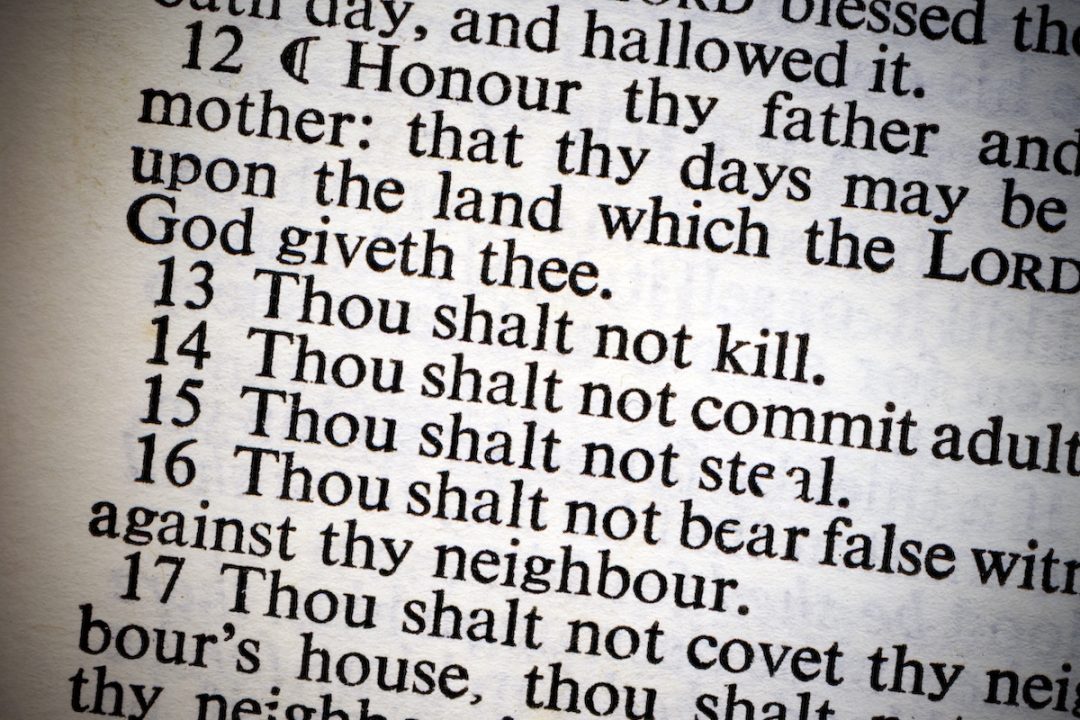
Should the Ten Commandments be displayed in public schools? With relatively new Arkansas, Louisiana, and Texas laws mandating such, this matter may soon come before the Supreme Court.
The reportage on this is interesting, too. The “Court may soon consider overturning 45-year precedent,” reads a recent Newsweek headline. Unmentioned is that this now-“45-year precedent” itself overturned a 193-year precedent: That of almost two centuries of American tradition and practices, nationwide and by numerous generations, based on consensus constitutional understanding. For it wasn’t uncommon for government schools to display the Ten Commandments prior to 1980. For that matter, the Bible was also typically used in American education in the late 18th and early 19th centuries.
Apparently, though, an entire civilization’s multi-generational determinations are irrelevant. Only the momentary judgments of a handful of lawyers in black robes can be considered “precedent.”
Yeah, It’s a Lemon All Right
Speaking of the black-robed lawyers, lawsuits have, predictably, been filed challenging the recent laws. Brought by groups of families from multiple religious backgrounds, the suits claim the laws violate the First Amendment. SCOTUSblog reported on the story last week, writing:
According to the families, students in classrooms with the Ten Commandments posters “will be forcibly subjected to scriptural dictates, day in and day out,” a situation that violates “the fundamental religious-freedom principles that animated the Founding of our nation.”
The Texas challengers, as well as the families in Arkansas and Louisiana, drew on a case from 1980, Stone v. Graham, in which the Supreme Court ruled, in an unsigned decision, that a Kentucky statute requiring a copy of the Ten Commandments to be hung in every public school classroom violated the establishment clause.
… The 5-4 opinion in Stone v. Graham centered on what’s known as the Lemon test, which came from a 1971 ruling, Lemon v. Kurtzman, which considered how to determine whether a state statute violates the establishment clause.
In that case, the court outlined a three-part test. First, a statute had to be found to have a secular purpose. Second, the statute could not promote or restrict religious beliefs or practices. And third, the statute could not foster excessive church-state entanglement (an admittedly nebulous standard).
In Stone, the majority determined Kentucky’s law violated the first prong, since the “preeminent purpose of posting the Ten Commandments” was “plainly religious in nature,” even if Kentucky lawmakers claimed they were celebrating the Ten Commandments’ historical, rather than religious, value.
Yet this is based on a fallacy. The Constitution does not state that a statute must have a “secular purpose.” This notion was invented by the courts out of whole cloth.
The Constitution Is the Only Precedent That Matters
But many judicial inventions have now become suppositions. Just consider remarks by Mikey Weinstein, founder and president of the Military Religious Freedom Foundation (MRFF). Weinstein, who opposes the state laws in question, told Newsweek, the site writes,
that his large civil rights organization “focuses on one thing and one thing only, and that is separation of church and state.”
That’s interesting.
Too bad it’s nowhere to be found in the Constitution.
As an MSN commenter on the Newsweek piece correctly stated:
“Separation of Church and State” was always bad law because it was never true, [sic] Yes, Jefferson used that phrase in his response to the Danbury Baptists, but that has no bearing on the meaning of the First Amendment. Allowing the Ten Commandments or bibles in school by no means “establish” a religion. Establishment, as applied to this amendment, meant a religion you MUST belong to or else face fines, penalties, and possibly imprisonment for noncompliance. That’s what the First Amendment was guarding against, not the practice of religion in the public sphere.
True. Government religious practice does not equate to government religious establishment. Were it otherwise, why would the Constitution’s creators, the Founders, have opened the very first Congress (1789) with Christian prayers? Were they oblivious to the meaning of the amendment they themselves crafted?
(Moreover, were their prayers not “religious in nature,” Mr. Lemon?)
Oh, this isn’t to say “separation” isn’t a constitutional principle. It’s found in the 1936 Soviet constitution — aka the Stalin constitution.
Whose “Values”?
Their scepticism about values is on the surface: it is for use on other people’s values: about the values current in their own set they are not nearly sceptical enough. And this phenomenon is very usual. A great many of those who “debunk” traditional or (as they would say) “sentimental” values have in the background values of their own which they believe to be immune from the debunking process.
The above passage, by philosopher C.S. Lewis, could come to mind when pondering certain “separation” arguments. For example, just consider comments by Rachel Laser, head of Americans United for Separation of Church and State. She warned, Newsweek relates, that schoolchildren are “a captive, impressionable audience that must be protected….”
Yet there’s an inherent contradiction here, one detected by another MSN respondent.
The people talking about separation and the trampling of their “civil liberties,” he wrote, “are all for indoctrination of our children with their leftist views.”
For sure. After all, if children are “impressionable,” which they are, they can be impressed with anything. And since there can’t in schools be nothing, but will be something, something will be impressed upon them.
“Values” Are Unavoidable
This brings us back to the claim that hanging the Ten Commandments “forcibly” subjects kids “to scriptural dictates, day in and day out.” If true, then hanging the “pride” flag subjects kids to “LGBTQ+” dictates, “day in and day out.” And what of posting messages about “diversity,” “inclusion,” or some trendy “ism”?
Related to this, Mikey Weinstein wondered “why Christianity is paramount in these displays,” writes Newsweek. Why not, instead, “the Code of Hammurabi”?
Well, why have in school feminism-oriented and not patriarchal suppositions? Why emphasize diversity and not a common culture? Why push “green” priorities and not economic ones? Why offer rice or potatoes at lunch and not couscous?
Such arguments are sophistry masquerading as sophistication. Qualitative judgments are made all the time; they are prerequisites for life and civilization. So some conception of virtue, of what is good, will always prevail. It’s just a question of which one it will be.
Lions and Tigers and Religion, Oh My!
At this point, the separation crowd may be left to say “But this is religion!” as if this itself is a debate-ending qualitative determination. But this, too, reflects a fallacy, as the following argument illustrates.
Imagine that the religious ideas in question really have been handed down by God, Creator of the Universe and Inerrant Author of All. Don’t we then have a duty to infuse our public sphere with them? Is it not then an imperative that we immerse schoolchildren in this divine light? Of course, naysayers may now respond, “Not everyone worships sky fairies! These are just man-made beliefs.”
All right, but if so, why say that the man-made beliefs we happen to call “secular” may be in the public square, but the man-made beliefs we happen to call “religious” may not be? If they’re all man-made, wherein lies the difference?
Conclusion: Either these beliefs are man-made, in which case they can share the table with other man-made ideas. They then may be in the public square.
Or they’re from God and must be there.
At the end of the day, the separation-of-church-and-state argument cannot prevail unless there’s first a separation of minds from reason. This is quite common, too, and lamentable — for it’s a madness that begets insane policy.




